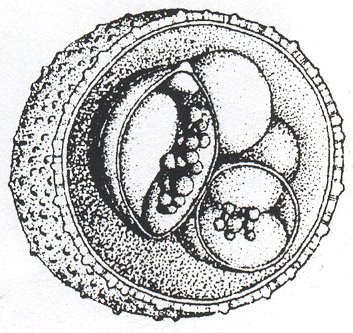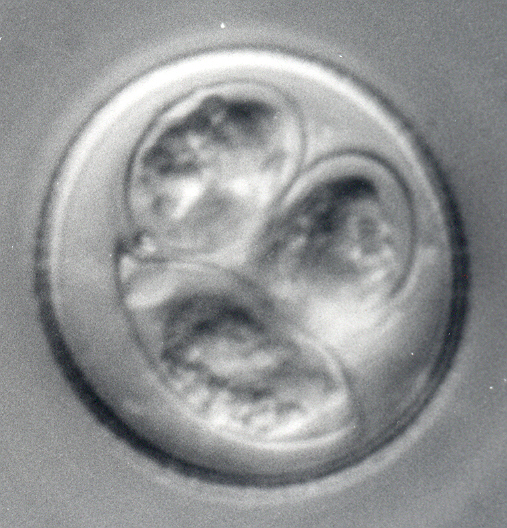Eimeria globula Duszynski and Wattam, 1988
Type host: Talpa europaea Linnaeus, 1758, European mole.
Other hosts: None reported to date.
Type locality: EUROPE: England: Norfolk, Thetford, Euston, TL 795 896, sheet 144.
Geographic distribution: EUROPE: England.


Description of oocyst:
Oocyst shape: spheroid to slightly subspheroid;
number of walls: 2;
wall thickness: ~1.0;
wall characteristics: outer, lightly mammillated, ~2/3 of total thickness and gives a striated apearance in optical cross section; inner, transparent;
L x W: 20.9 x 19.9 (19-24 x 17-21);
L/W ratio: 1.05 (1.0-1.2);
M: absent;
OR: absent;
PG: absent.
Distinctive features of oocyst: rough outer wall and striated appearance in optical cross section.
Description of sporocysts and sporozoites:
Sporocyst shape: elongate-ovoid, distinctly pointed at both ends;
L x W: 11.5 x 6.9 (9-16 x 6-9);
L/W ratio: 1.7 (1.5-2.7);
SB: present;
SSB: present, 2-3 times as wide as SB;
PSB: absent;
SR: present;
SR characteristics: many small globules often concentrated on one side of sporocyst;
SP: neither SP nor RB were mentioned in the original description.
Distinctive features of sporocyst: pointed at both ends and large size of SSB.
Prevalence: 3/33 (9%).
Sporulation: Exogenous. Oocysts were sporulated when returned to the laboratory from the field.
Prepatent and patent periods: Unknown.
Site of infection: Unknown. Oocysts recovered from feces and intestinal contents.
Materials deposited: Skin of the symbiotype host is preserved in the Ministry of Agriculture, Fisheries and Food, Tolworth Laboratory, Surrey, England, R. Redfern #274, 23 November, 1982. Photosyntypes in the USNPC No. 85984 .
Remarks: Oocysts of this species are nearly identical in size and shape to those of E. brevicauda from B. brevicauda, a shrew from the USA. In addition to host and geographic differences, the oocysts of this species lack a PB, which those of E. brevicauda possess, and the SSB of E. globula is always 2-3 times wider than the SB; whereas in E. brevicauda, the SB and SSB are of equal width. Qualitatively, the shape of the SBs are very different between them.
References: Duszynski and Wattam (1988).



